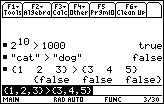TI-BASIC:Greaterthan
Command Summary
Returns true if value1 is greater than value2.
Command Syntax
value1>value2
Menu Location
Press:
- 2nd TEST to access the test menu.
- 3 to select >, or use arrows.
TI-83/84/+/SE
1 byte
The > (greater than) operator takes two numbers, variables, or expressions, and tests to see if the first one has a value greater than the second one. It will return 1 if it is greater, and 0 if it is not. When determining the order of operations, > will be executed after the math operators, but it will be executed before the logical operators and in the order that it appears from left to right with the other relational operators.
:1>0
1
:DelVar X3→Y
:X>Y
0
Advanced Uses
Just like the other relational operators, > can take real numbers and lists for variables. In order to compare the lists, however, both must have the same dimensions; if they don't, the calculator will throw a ERR:DIM MISMATCH error. When comparing a real number to a list, the calculator will actually compare the number against each element in the list and return a list of 1s and 0s accordingly.
:{2,4,6,8}>{1,3,5,7
{1 1 1 1}
:5>{1,2,3,4,5
{1 1 1 1 0}
Unfortunately, > does not work with strings, matrices, or complex numbers (only = and ≠ do), and the calculator will actually throw a ERR:DATA TYPE error if you try to compare them. In the case of strings, however, it should be pretty obvious why: a string represents a sequence of characters, and does not associate a value to any character, so there is nothing to compare.
Error Conditions
- ERR:DATA TYPE is thrown if you try to compare strings, matrices, or complex numbers.
- ERR:DIM MISMATCH is thrown if you try to compare two lists that have different dimensions.
